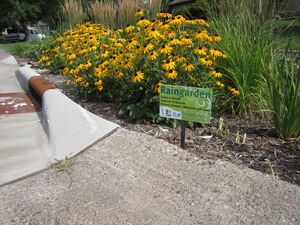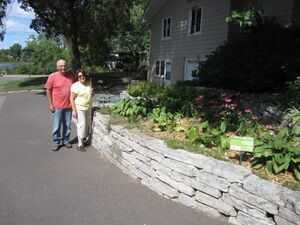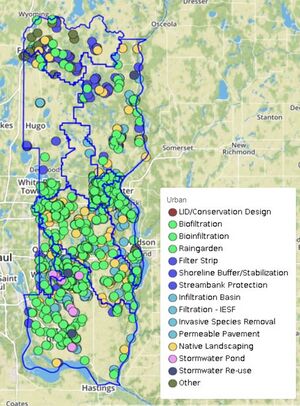
Measuring Behavioral Change: East Metro Water Resource Education Program (EMWREP)
Creating behavioral change is a goal of many education and outreach programs. For example, the goal of many education and outreach programs related to environmental issues is to foster environmental stewardship amongst members of the public leading to individual action (e.g., adoption of a catch basin, abandoning use of lawn fertilizer, etc.). For this reason, to understand the impact of education efforts, it is critical to gather data related to public perception prior to and after education efforts, and to track environmental action taken by members of the public.
The East Metro Water Resource Education Program (EMWREP) is a local government partnership with 25 members, including: Washington Conservation District (host); Washington County; Brown’s Creek, Carnelian-Marine-St. Croix, Comfort-Lake Forest Lake, Rice Creek, Ramsey-Washington Metro, South Washington, and Valley Branch Watershed Districts, and the Middle St. Croix Watershed Management Organization; and the communities of Bayport, Cottage Grove, Dellwood, Forest Lake, Grant, Hugo, Lake Elmo, Newport, Oakdale, Oak Park Heights, Stillwater, St. Paul Park, Willernie, Woodbury and West Lakeland Township. The goal of the EMWREP is to educate community residents, businesses, staff, and decision-makers about issues affecting local lakes, rivers, streams, wetlands and groundwater resources and to engage people in projects that will help to protect and improve the health of these water resources.
The EMWREP partnership was formed in 2006. At the time, there were less than ten (10) voluntary residential best management practices (BMPs) constructed in Washington County. One of the first goals identified by the group was to work with private landowners to install residential BMPs such as raingardens and native shoreline plantings. To better understand public perception and education related to water resources and water quality BMPs, EMWREP partnered with research assistants from the University of Minnesota and Great River Greening, an environmental conservation nonprofit, to conduct surveys and focus groups with residents of Cottage Grove, Woodbury, and Forest Lake. The goal of these surveys was to identify opportunities and barriers to installing residential raingardens and native shoreline plantings.
Information collected from initial surveys indicated that homeowners most-highly value an attractive yard and tend to prefer “tidier” looking raingardens and landscapes. In response, EMWREP tailored promotional programs to emphasize the aesthetic value of raingardens (see biofiltration and bioinfiltration and native plantings, ahead of promoting their water quality benefits. Additionally, EMWREP worked with conservation district staff to incorporate elements such as edging and plant massing to make native raingardens look more intentional and landscaped. Partnering with Blue Thumb – Planting for Clean Water, an outreach program of the Rice Creek Watershed District, EMWREP hosted several professional trainings for private landscaping companies and local government staff to learn how to properly design and install raingardens and native plantings and coordinated with watershed management organizations in Washington County to develop cost-share programs to incentivize construction of residential BMPs.
To evaluate the impact of education and outreach efforts, EMWREP conducted a survey of 143 community residents who had attended Blue Thumb workshops, requested site visits, or completed BMP projects since 2006. The survey reinforced the value of the watershed cost share grants, technical assistance through the conservation district, and word of mouth advertising from neighbors and friends. Similar surveys were conducted in 2015 (433 people) and 2020 (556 people). In the 2020 survey, people who completed BMP projects most often said they were motivated by protecting a nearby water body from polluted runoff, improving habitat for wildlife and pollinators, or beautifying their yard’s existing landscaping. Common barriers to completing a project include time, funding, and communication during the grant application and approval process. Approximately 30% of workshop attendees complete a project, but more than 50% of residents complete projects without ever attending a workshop first.
In response to surveying efforts, EMWREP developed an Adopt-a-Raingarden program to provide BMP maintenance support. Additionally, the Washington Conservation District contracts with cities and watersheds to conduct maintenance, sometimes with support from Minnesota Conservation Corps. Maintenance resources can be found at the Adopt-a-Raingarden website.
More information regarding the EMWREP by visiting the Washington Conservation District website (http://www.mnwcd.org/) or by contacting Angie Hong (angie.hong@mnwcd.org),
Project Location: Communities and local governments located in the East Metro (web map). Completion Date: 2006 to Present (Ongoing) Organizations Involved: EMWREP, Washington Conservation District, Blue Thumb—Planting for Clean Water, University of Minnesota, and Great River Greening. Project Budget Summary:
- EMWREP is a comprehensive water education program that conducts hundreds of educational activities per year. For 2020, the program budget is $150,000.
- The annual cost of each watershed’s residential BMP program ranges from $5,000-$50,000
Quantitative Outcomes: EMWREP partners maintain a BMP project database (http://www.mapfeeder.net/wcdbmp/) that shows the locations of urban and agricultural projects in Washington County. To date, there are 1500 urban BMP projects tracked.
This page was last edited on 26 January 2023, at 22:35.



